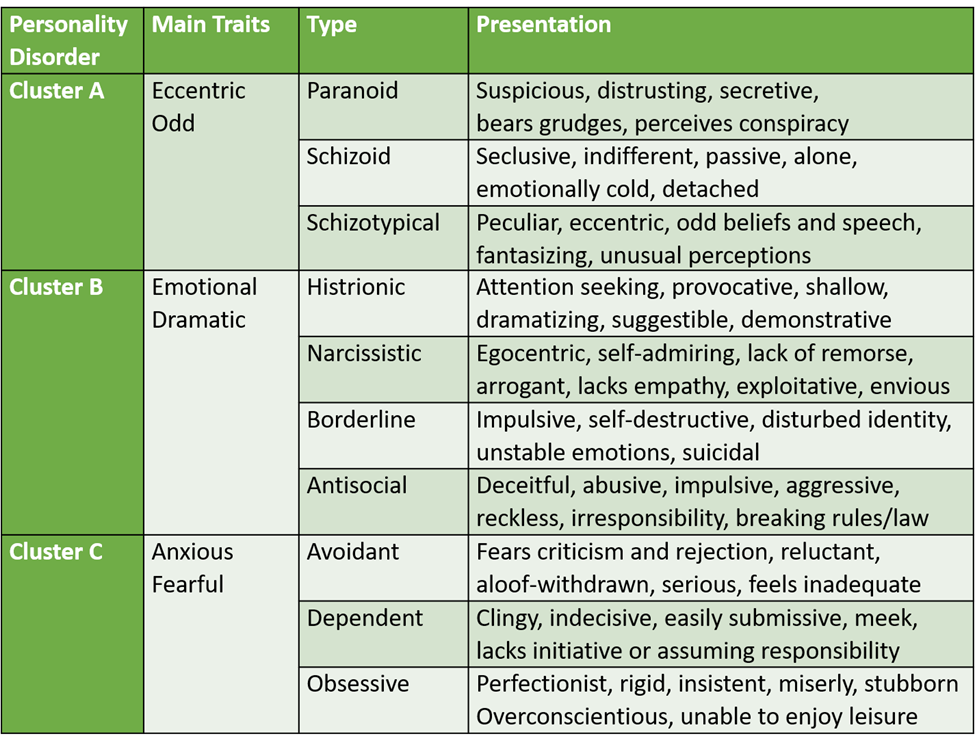Which nursing diagnosis should be prioritized when providing care to a client diagnosed with paranoid personality disorder?
Social isolation RUT inability to relate to others
Risk for suicide R/T altered thought
Altered sensory perception RUT increased levels of anxiety
Risk for violence: directed toward others R/T suspicious thoughts
The Correct Answer is D
A. Social isolation R/T inability to relate to others
While social isolation may be a concern for individuals with paranoid personality disorder, the immediate safety risk associated with the disorder is more related to the potential for violence. Therefore, addressing the risk of violence takes precedence.
B. Risk for suicide R/T altered thought:
Paranoid personality disorder is not typically associated with a high risk of suicide. Individuals with this disorder are more likely to pose a risk to others due to their suspicious thoughts and mistrust. Suicide risk assessments are crucial but may not be the top priority in this specific case.
C. Altered sensory perception R/T increased levels of anxiety:
Paranoid personality disorder does involve heightened levels of anxiety, but altered sensory perception is not a primary characteristic of the disorder. Addressing anxiety is important, but the potential for violence toward others is a more immediate concern.
D. Risk for violence: directed toward others R/T suspicious thoughts:
This is the most appropriate priority. Individuals with paranoid personality disorder may have intense mistrust and suspicion, leading to the potential for aggressive or violent behavior directed toward others. Prioritizing safety and preventing harm to others is crucial in the care of clients with this disorder.

Nursing Test Bank
Naxlex Comprehensive Predictor Exams
Related Questions
Correct Answer is C
Explanation
A. Dry mouth and urinary retention: These symptoms are not typically associated with the side effects of clozapine. Dry mouth is a common side effect of many antipsychotic medications, but urinary retention is not a typical side effect of clozapine.
B. Akinesia and insomnia: Akinesia (lack of movement) is not a common side effect of clozapine. Insomnia can occur with various antipsychotic medications but does not typically warrant immediate intervention unless severe or persistent.
C. Sore throat, fever, and malaise: These symptoms can indicate a potentially serious side effect known as agranulocytosis, which is a significant reduction in white blood cell count. Clozapine is associated with an increased risk of agranulocytosis. If a client experiences symptoms such as sore throat, fever, or malaise, it may indicate a severe drop in white blood cell count, and immediate medical attention is necessary.
D. Akathisia and hypersalivation: Akathisia (restlessness) is a known side effect of antipsychotic medications, but it is not typically associated with immediate severe medical risks. Hypersalivation is a common side effect but does not usually require immediate intervention unless severe.
Correct Answer is B
Explanation
A. The client will substitute a productive activity for rituals by day one: This outcome may be challenging to achieve within the first day, and it is important to set realistic goals. Moreover, focusing on substituting a productive activity might not address the immediate need to reduce ritualistic behaviors.
B. The client will refrain from ritualistic behaviors during daylight hours: This is an appropriate initial outcome. It acknowledges the challenge of completely eliminating rituals but sets a realistic goal of refraining from these behaviors during daylight hours. This allows for gradual progress without setting unrealistic expectations.
C. The client will participate in unit activities by day three: While participation in unit activities is a positive goal, it may be too optimistic to expect this within the first three days, especially considering the severity of obsessive-compulsive disorder symptoms.
D. The client will wake early enough to complete rituals prior to breakfast: This goal does not promote a reduction in ritualistic behaviors; instead, it may reinforce and accommodate the rituals. The aim of treatment for obsessive-compulsive disorder is to reduce the impact of these rituals, not to support them.
Whether you are a student looking to ace your exams or a practicing nurse seeking to enhance your expertise , our nursing education contents will empower you with the confidence and competence to make a difference in the lives of patients and become a respected leader in the healthcare field.
Visit Naxlex, invest in your future and unlock endless possibilities with our unparalleled nursing education contents today
Report Wrong Answer on the Current Question
Do you disagree with the answer? If yes, what is your expected answer? Explain.
Kindly be descriptive with the issue you are facing.
